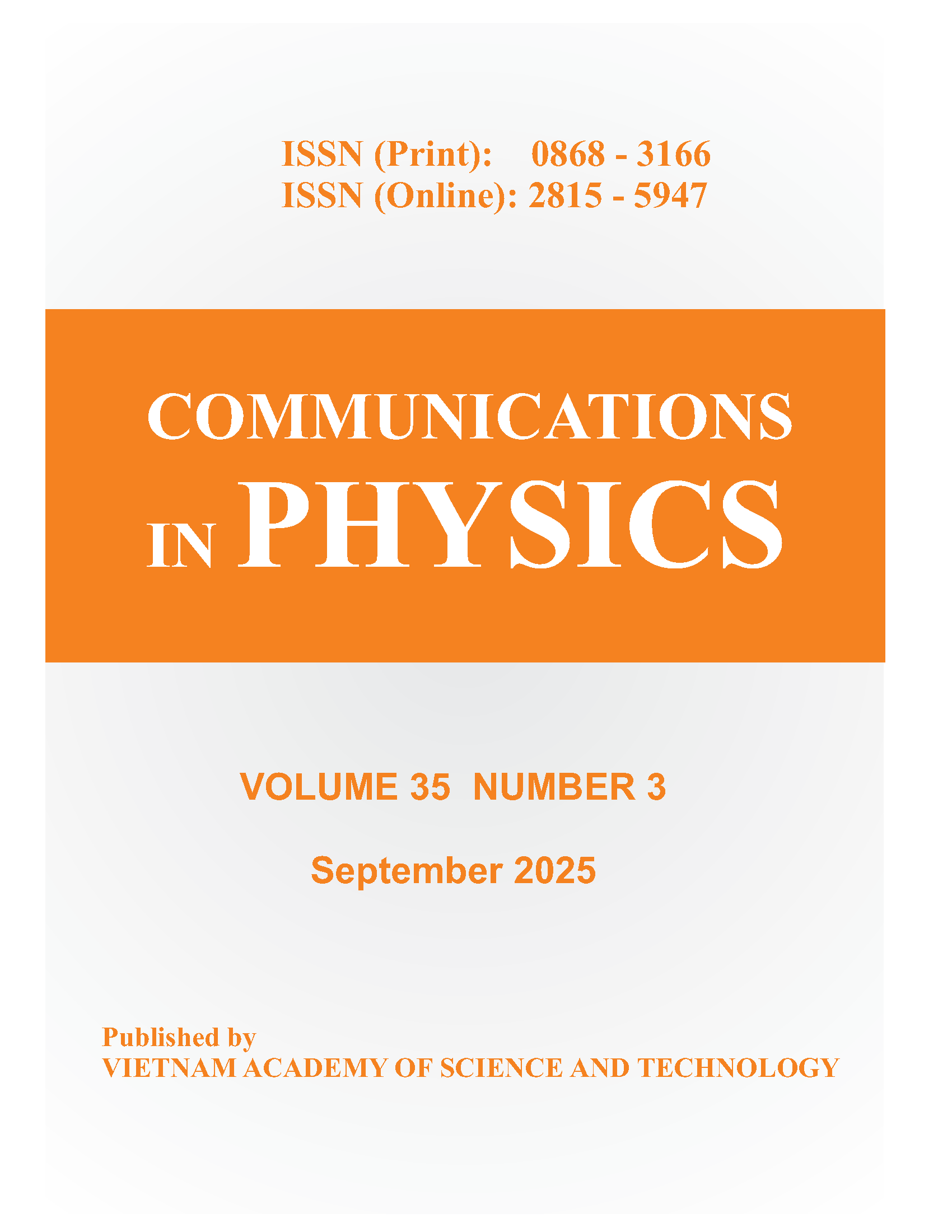Hybridization of an s-wave impurity with graphene lattice
Author affiliations
DOI:
https://doi.org/10.15625/0868-3166/20492Keywords:
Kondo effect, GrapheneAbstract
Hybridization function is a quantity characterizing electron hoppings between an impurity and a host material in which the impurity resides, a full understandinging of it is crucial for studying correlation effects in various impurity problems. This work studies the hybridization function for the Anderson impurity model describing a single-orbital impurity on a honeycomb lattice simulating graphene and presents a calculation approach to obtain this function at low energy. Within this approach, the general form of the hybridization function in graphene is presented and analytical expressions of low-energy hybridization spectrum are obtained. The results quantitatively match numerical solutions for different impurity positions on the lattice. The effect of the low-energy hybridization spectrum and the capability to predict the correlated effects of the impurity problem are discussed thoroughly, suggesting that different types of pseudogap Kondo effect may occur at different impurity positions.
Downloads
References
K. S. Novoselov et al., Electric field effect in atomically thin carbon films, Science 306 (2004) 666.
Y. Zhang, Y.-W. Tan, H. L. Stormer and P. Kim, Experimental observation of the quantum hall effect and berry’s phase in graphene, Nature 438 (2005) 201.
K. S. Novoselov et al., Two-dimensional gas of massless dirac fermions in graphene, nature 438 (2005) 197.
A. H. Castro Neto, F. Guinea, N. M. R. Peres, K. S. Novoselov and A. K. Geim, The electronic properties of graphene, Rev. Mod. Phys. 81 (2009) 109.
J. Ren et al., Kondo effect of cobalt adatoms on a graphene monolayer controlled by substrate-induced ripples, Nano Letters 14 (2014) 4011 [https://doi.org/10.1021/nl501425n].
V. W. Brar et al., Gate-controlled ionization and screening of cobalt adatoms on a graphene surface, Nature Physics 7 (2011) 43.
L. Fritz and M. Vojta, The physics of kondo impurities in graphene, Reports on Progress in Physics 76 (2013) 032501.
A. C. Hewson, The Kondo problem to heavy fermions, vol. 2. Cambridge university press, 1997.
D. Withoff and E. Fradkin, Phase transitions in gapless fermi systems with magnetic impurities, Phys. Rev. Lett. 64 (1990) 1835.
R. Bulla, T. Pruschke and A. C. Hewson, Anderson impurity in pseudo-gap fermi systems, Journal of Physics: Condensed Matter 9 (1997) 10463.
C. Gonzalez-Buxton and K. Ingersent, Renormalization-group study of anderson and kondo impurities in gapless fermi systems, Phys. Rev. B 57 (1998) 14254.
J. H. Pixley, S. Kirchner, K. Ingersent and Q. Si, Kondo destruction and valence fluctuations in an anderson model, Phys. Rev. Lett. 109 (2012) 086403.
P. Gegenwart, Q. Si and F. Steglich, Quantum criticality in heavy-fermion metals, nature physics 4 (2008) 186.
P. W. Anderson, Localized magnetic states in metals, Phys. Rev. 124 (1961) 41.
H. T. Dang and H. T. M. Nghiem, Phase diagram of a pseudogap anderson model with application to graphene, arXiv:2107.09854 [cond-mat.str-el] (2021) [2107.09854].
A. Georges, L. d. Medici and J. Mravlje, Strong correlations from hund’s coupling, Annual Review of Condensed Matter Physics 4 (2013) 137.
A. Georges, G. Kotliar, W. Krauth and M. J. Rozenberg, Dynamical mean-field theory of strongly correlated fermion systems and the limit of infinite dimensions, Rev. Mod. Phys. 68 (1996) 13.
J. W. Negele and H. Orland, Quantum many-particle systems. CRC Press, 2018.
E. Gull et al., Continuous-time monte carlo methods for quantum impurity models, Rev. Mod. Phys. 83 (2011) 349.
A. A. Abrikosov, L. P. Gorkov and I. E. Dzyaloshinski, Methods of quantum field theory in statistical physics. Courier Corporation, 2012.
C. R. Cassanello and E. Fradkin, Kondo effect in flux phases, Phys. Rev. B 53 (1996) 15079.
L. Fritz and M. Vojta, Phase transitions in the pseudogap anderson and kondo models: Critical dimensions, renormalization group, and local-moment criticality, Phys. Rev. B 70 (2004) 214427.
M. Vojta and L. Fritz, Upper critical dimension in a quantum impurity model: Critical theory of the asymmetric pseudogap kondo problem, Phys. Rev. B 70 (2004) 094502.
N. W. Ashcroft and N. D. Mermin, Solid State Physics. Holt-Saunders, 1976.
Downloads
Published
How to Cite
Issue
Section
License
Communications in Physics is licensed under a Creative Commons Attribution-ShareAlike 4.0 International License.
Copyright on any research article published in Communications in Physics is retained by the respective author(s), without restrictions. Authors grant VAST Journals System (VJS) a license to publish the article and identify itself as the original publisher. Upon author(s) by giving permission to Communications in Physics either via Communications in Physics portal or other channel to publish their research work in Communications in Physics agrees to all the terms and conditions of https://creativecommons.org/licenses/by-sa/4.0/ License and terms & condition set by VJS.
Funding data
-
National Foundation for Science and Technology Development
Grant numbers 103.02-2021.95











